Nikon B500 vs W300
The Nikon Coolpix B500 and the Nikon Coolpix W300 are two digital cameras that were officially introduced, respectively, in January 2016 and May 2017. Both the B500 and the W300 are fixed lens compact cameras that are equipped with a 1/2.3-inch sensor. Both cameras offer a resolution of 15.9 megapixels.
Below is an overview of the main specs of the two cameras as a starting point for the comparison.

Check B500 offers at
ebay.com

Check W300 offers at
ebay.com
Going beyond this snapshot of core features and characteristics, what are the differences between the Nikon Coolpix B500 and the Nikon Coolpix W300? Which one should you buy? Read on to find out how these two cameras compare with respect to their body size, their imaging sensors, their shooting features, their input-output connections, and their reception by expert reviewers.
Body comparison
An illustration of the physical size and weight of the Nikon B500 and the Nikon W300 is provided in the side-by-side display below. The two cameras are presented according to their relative size. Three successive views from the front, the top, and the rear are shown. All width, height and depth dimensions are rounded to the nearest millimeter.
The B500 can be obtained in two different colors (black, red), while the W300 is available in three color-versions (black, orange, yellow).
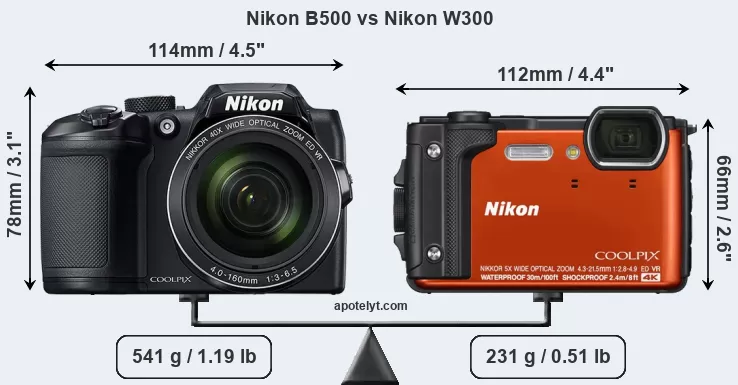
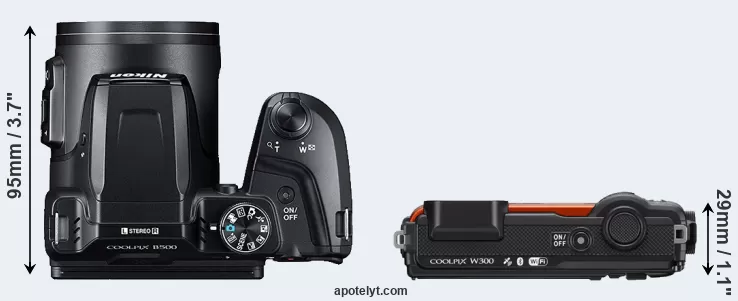
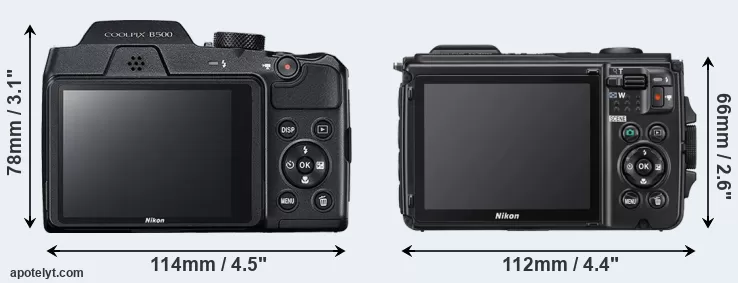
If the front view area (width x height) of the cameras is taken as an aggregate measure of their size, the Nikon W300 is notably smaller (17 percent) than the Nikon B500. Moreover, the W300 is substantially lighter (57 percent) than the B500. It is noteworthy in this context that the W300 is splash and dust-proof, while the B500 does not feature any corresponding weather-sealing. More than that, the W300 is water-proof up to 30m and can, thus, be used for underwater photography.
The power pack in the W300 can be charged via the USB port, which can be very convenient when travelling.
The following table provides a synthesis of the main physical specifications of the two cameras and other similar ones. If you would like to visualize and compare a different camera combination, you can navigate to the CAM-parator app and make your selection from a broad list of cameras there.

| Camera Model |
Camera Width |
Camera Height |
Camera Depth |
Camera Weight |
Battery Life |
Weather Sealing |
Camera Launch |
Launch Price (USD) |
Street Price |
||
|---|---|---|---|---|---|---|---|---|---|---|---|
| 1. | Nikon B500 | 114 mm | 78 mm | 95 mm | 541 g | 600 | n | Jan 2016 | 299 | ebay.com | |
| 2. | Nikon W300 | 112 mm | 66 mm | 29 mm | 231 g | 280 | Y | May 2017 | 389 | ebay.com | |
| 3. | Nikon A1000 | 114 mm | 72 mm | 41 mm | 330 g | 250 | n | Jan 2019 | 429 | ebay.com | |
| 4. | Nikon B600 | 122 mm | 82 mm | 99 mm | 500 g | 280 | n | Jan 2019 | 349 | ebay.com | |
| 5. | Nikon B700 | 125 mm | 85 mm | 107 mm | 565 g | 350 | n | Feb 2016 | 499 | ebay.com | |
| 6. | Nikon L840 | 113 mm | 78 mm | 96 mm | 538 g | 590 | n | Feb 2015 | 299 | ebay.com | |
| 7. | Nikon P900 | 140 mm | 103 mm | 137 mm | 899 g | 360 | n | Mar 2015 | 599 | ebay.com | |
| 8. | Nikon P1000 | 146 mm | 119 mm | 181 mm | 1415 g | 250 | n | Jul 2018 | 999 | amazon.com | |
| 9. | Olympus TG-5 | 113 mm | 66 mm | 32 mm | 250 g | 340 | Y | May 2017 | 449 | ebay.com | |
| 10. | Panasonic FZ80 | 130 mm | 94 mm | 119 mm | 616 g | 330 | n | Jan 2017 | 399 | ebay.com | |
| 11. | Panasonic TS7 | 117 mm | 76 mm | 37 mm | 319 g | 300 | Y | May 2018 | 449 | ebay.com | |
| 12. | Ricoh WG-60 | 123 mm | 62 mm | 30 mm | 193 g | 300 | Y | Oct 2018 | 279 | ebay.com | |
| 13. | Sony H200 | 123 mm | 83 mm | 87 mm | 530 g | 240 | n | Jan 2013 | 249 | ebay.com | |
| 14. | Sony HX80 | 102 mm | 58 mm | 36 mm | 245 g | 390 | n | Mar 2016 | 349 | ebay.com | |
| 15. | Sony WX800 | 102 mm | 58 mm | 36 mm | 233 g | 370 | n | Oct 2018 | 399 | ebay.com | |
| Note: Measurements and pricing do not include easily detachable parts, such as add-on or interchangeable lenses or optional viewfinders. | |||||||||||
Any camera decision will obviously take relative prices into account. The manufacturer’s suggested retail prices give an idea on the placement of the camera in the maker’s lineup and the broader market. The B500 was launched at a somewhat lower price (by 23 percent) than the W300, which makes it more attractive for photographers on a tight budget. Normally, street prices remain initially close to the MSRP, but after a couple of months, the first discounts appear. Later in the product cycle and, in particular, when the replacement model is about to appear, further discounting and stock clearance sales often push the camera price considerably down.
Sensor comparison
The size of the sensor inside a digital camera is one of the key determinants of image quality. All other things equal, a large sensor will have larger individual pixel-units that offer better low-light sensitivity, wider dynamic range, and richer color-depth than smaller pixels in a sensor of the same technological generation. Furthermore, a large sensor camera will give the photographer more possibilities to use shallow depth-of-field in order to isolate a subject from the background. On the downside, larger sensors are more costly to manufacture and tend to lead to bigger and heavier cameras and lenses.
Both cameras under consideration feature a 1/2.3-inch sensor and have a format factor (sometimes also referred to as "crop factor") of 5.6. Within the spectrum of camera sensors, this places the review cameras among the smaller-sensor digicams that favor affordability and compact design. Both cameras feature a native aspect ratio (sensor width to sensor height) of 4:3.
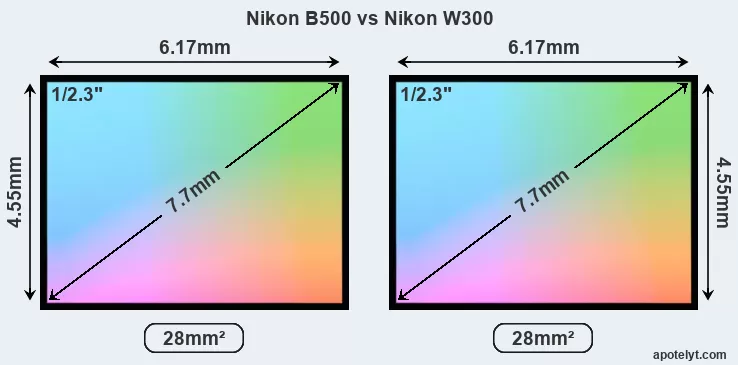
The two cameras under review do not only share the same sensor size, but also offer an identical resolution of 15.9 megapixels. This similarity in sensor specs implies that both the B500 and the W300 have the same pixel density, as well as the same pixel size. It should, however, be noted that the W300 is a somewhat more recent model (by 1 year and 4 months) than the B500, and its sensor might have benefitted from technological advances during this time. Coming back to sensor resolution, it should be mentioned that the B500 has no anti-alias filter installed, so that it can capture all the detail its sensor resolves.
The Nikon Coolpix B500 has a native sensitivity range from ISO 80 to ISO 6400. The corresponding ISO settings for the Nikon Coolpix W300 are ISO 125 to ISO 1600, with the possibility to increase the ISO range to 125-6400.
Technology-wise, both cameras are equipped with BSI-CMOS (Backside Illuminated Complementary Metal–Oxide–Semiconductor) sensors. Both cameras use a Bayer filter for capturing RGB colors on a square grid of photosensors. This arrangement is found in most digital cameras.
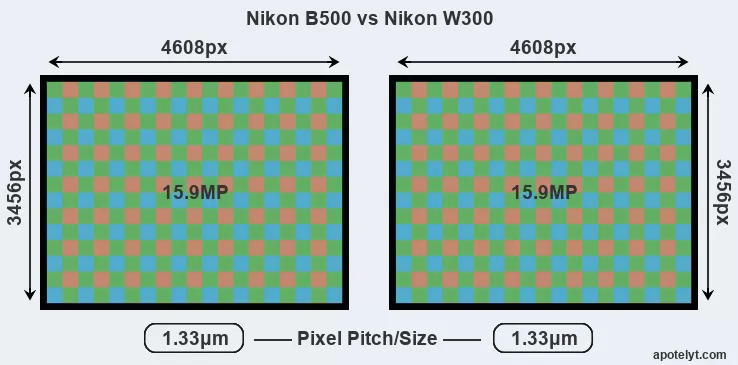
For many cameras, data on sensor performance has been reported by DXO Mark. This service is based on lab testing and assigns an overall score to each camera sensor, as well as ratings for dynamic range ("DXO Landscape"), color depth ("DXO Portrait"), and low-light sensitivity ("DXO Sports"). The adjacent table reports on the physical sensor characteristics and the outcomes of the DXO sensor quality tests for a sample of comparator-cameras.

| Camera Model |
Sensor Class |
Resolution (MP) |
Horiz. Pixels |
Vert. Pixels |
Video Format |
DXO Portrait |
DXO Landscape |
DXO Sports |
DXO Overall |
||
|---|---|---|---|---|---|---|---|---|---|---|---|
| 1. | Nikon B500 | 1/2.3 | 15.9 | 4608 | 3456 | 1080/60i | 20.3 | 11.7 | 810 | 48 | |
| 2. | Nikon W300 | 1/2.3 | 15.9 | 4608 | 3456 | 4K/30p | 20.5 | 12.0 | 938 | 50 | |
| 3. | Nikon A1000 | 1/2.3 | 15.9 | 4608 | 3456 | 4K/30p | 20.7 | 12.2 | 1095 | 52 | |
| 4. | Nikon B600 | 1/2.3 | 15.9 | 4608 | 3456 | 1080/30p | 20.7 | 12.2 | 1095 | 52 | |
| 5. | Nikon B700 | 1/2.3 | 20.2 | 5184 | 3888 | 4K/30p | 20.4 | 11.8 | 818 | 48 | |
| 6. | Nikon L840 | 1/2.3 | 15.9 | 4608 | 3456 | 1080/60i | 20.2 | 11.6 | 721 | 47 | |
| 7. | Nikon P900 | 1/2.3 | 15.9 | 4608 | 3456 | 1080/60p | 20.2 | 11.6 | 727 | 47 | |
| 8. | Nikon P1000 | 1/2.3 | 15.9 | 4608 | 3456 | 4K/30p | 20.6 | 12.1 | 1044 | 51 | |
| 9. | Olympus TG-5 | 1/2.3 | 12.0 | 4000 | 3000 | 4K/30p | 20.5 | 11.9 | 934 | 50 | |
| 10. | Panasonic FZ80 | 1/2.3 | 18.0 | 4896 | 3672 | 4K/30p | 20.5 | 11.9 | 900 | 49 | |
| 11. | Panasonic TS7 | 1/2.3 | 20.2 | 5184 | 3888 | 4K/30p | 20.6 | 12.1 | 1028 | 51 | |
| 12. | Ricoh WG-60 | 1/2.3 | 15.9 | 4608 | 3456 | 1080/60p | 20.6 | 12.2 | 1072 | 51 | |
| 13. | Sony H200 | 1/2.3 | 15.2 | 5184 | 2930 | 720/30p | 19.9 | 11.2 | 529 | 44 | |
| 14. | Sony HX80 | 1/2.3 | 18.0 | 4896 | 3672 | 1080/60p | 20.4 | 11.8 | 822 | 48 | |
| 15. | Sony WX800 | 1/2.3 | 18.0 | 4896 | 3672 | 4K/30p | 20.6 | 12.2 | 1070 | 51 | |
| Note: DXO values in italics represent estimates based on sensor size and age. | |||||||||||
Many modern cameras are not only capable of taking still images, but can also record movies. The two cameras under consideration both have sensors whose read-out speed is fast enough to capture moving pictures, but the W300 provides a better video resolution than the B500. It can shoot movie footage at 4K/30p, while the B500 is limited to 1080/60i.
Feature comparison
Apart from body and sensor, cameras can and do differ across a range of features. The B500 and the W300 are similar in the sense that neither of the two has a viewfinder. The images are, thus, framed using live view on the rear LCD. The following table reports on some other key feature differences and similarities of the Nikon B500, the Nikon W300, and comparable cameras.

| Camera Model |
Viewfinder (Type or 000 dots) |
Control Panel (yes/no) |
LCD Specifications (inch/000 dots) |
LCD Attach- ment |
Touch Screen (yes/no) |
Max Shutter Speed * |
Max Shutter Flaps * |
Built-in Flash (yes/no) |
Built-in Image Stab |
||
|---|---|---|---|---|---|---|---|---|---|---|---|
| 1. | Nikon B500 | none | n | 3.0 / 921 | tilting | n | 1/4000s | 7.4/s | Y | Y | |
| 2. | Nikon W300 | none | n | 3.0 / 921 | fixed | n | 1/4000s | 7.0/s | Y | Y | |
| 3. | Nikon A1000 | 1166 | n | 3.0 / 1036 | tilting | Y | 1/4000s | 7.0/s | Y | Y | |
| 4. | Nikon B600 | none | n | 3.0 / 921 | fixed | n | 1/4000s | 7.4/s | Y | Y | |
| 5. | Nikon B700 | 921 | n | 3.0 / 921 | swivel | n | 1/4000s | 5.0/s | Y | Y | |
| 6. | Nikon L840 | none | n | 3.0 / 921 | tilting | n | 1/4000s | 7.4/s | Y | Y | |
| 7. | Nikon P900 | 921 | n | 3.0 / 921 | swivel | n | 1/4000s | 7.0/s | Y | Y | |
| 8. | Nikon P1000 | 2359 | n | 3.2 / 921 | swivel | n | 1/4000s | 7.0/s | Y | Y | |
| 9. | Olympus TG-5 | none | n | 3.0 / 460 | fixed | n | 1/2000s | 20.0/s | Y | Y | |
| 10. | Panasonic FZ80 | 1166 | n | 3.0 / 1040 | fixed | Y | 1/2000s | 10.0/s | Y | Y | |
| 11. | Panasonic TS7 | 1170 | n | 3.0 / 1040 | fixed | n | 1/1300s | 10.0/s | Y | Y | |
| 12. | Ricoh WG-60 | none | n | 2.7 / 230 | fixed | n | 1/4000s | 8.0/s | Y | n | |
| 13. | Sony H200 | none | n | 3.0 / 460 | fixed | n | 1/1500s | 0.8/s | Y | Y | |
| 14. | Sony HX80 | 638 | n | 3.0 / 922 | tilting | n | 1/2000s | 10.0/s | Y | Y | |
| 15. | Sony WX800 | none | n | 3.0 / 922 | tilting | Y | 1/2000s | 10.0/s | Y | Y | |
| Note: *) Information refers to the mechanical shutter, unless the camera only has an electronic one. | |||||||||||
Both the B500 and the W300 have zoom lenses built in. The B500 has a 22.5-900mm f/3.0-6.5 optic and the W300 offers a 24-120mm f/2.8-4.9 (focal lengths in full frame equivalent terms). Hence, the B500 provides a wider angle of view at the short end, as well as more tele-photo reach at the long end than the W300. The W300 offers the faster maximum aperture.
Concerning the storage of imaging data, both the B500 and the W300 write their files to SDXC cards.
Connectivity comparison
For some imaging applications, the extent to which a camera can communicate with its environment can be an important aspect in the camera decision process. The table below provides an overview of the connectivity of the Nikon Coolpix B500 and Nikon Coolpix W300 and, in particular, the interfaces the cameras (and selected comparators) provide for accessory control and data transfer.

| Camera Model |
Hotshoe Port |
Internal Mic / Speaker |
Microphone Port |
Headphone Port |
HDMI Port |
USB Port |
WiFi Support |
NFC Support |
Bluetooth Support |
||
|---|---|---|---|---|---|---|---|---|---|---|---|
| 1. | Nikon B500 | - | stereo / mono | - | - | micro | 2.0 | Y | Y | Y | |
| 2. | Nikon W300 | - | stereo / mono | - | - | micro | 2.0 | Y | - | Y | |
| 3. | Nikon A1000 | - | stereo / mono | - | - | micro | 2.0 | Y | - | Y | |
| 4. | Nikon B600 | - | stereo / mono | - | - | micro | 2.0 | Y | - | Y | |
| 5. | Nikon B700 | - | stereo / mono | - | - | micro | 2.0 | Y | Y | Y | |
| 6. | Nikon L840 | - | stereo / mono | - | - | micro | 2.0 | Y | Y | - | |
| 7. | Nikon P900 | - | stereo / mono | - | - | micro | 2.0 | Y | Y | - | |
| 8. | Nikon P1000 | Y | stereo / mono | Y | - | micro | 2.0 | Y | - | Y | |
| 9. | Olympus TG-5 | - | stereo / mono | - | - | micro | 2.0 | Y | - | - | |
| 10. | Panasonic FZ80 | Y | stereo / mono | - | - | micro | 2.0 | Y | - | - | |
| 11. | Panasonic TS7 | - | stereo / mono | - | - | micro | 2.0 | Y | - | - | |
| 12. | Ricoh WG-60 | - | mono / mono | - | - | micro | 2.0 | - | - | - | |
| 13. | Sony H200 | - | mono / mono | - | - | - | 2.0 | - | - | - | |
| 14. | Sony HX80 | - | stereo / mono | - | - | micro | 2.0 | Y | Y | - | |
| 15. | Sony WX800 | - | stereo / mono | - | - | micro | 2.0 | Y | Y | - |
Travel and landscape photographers will find it useful that the W300 has an internal geolocalization sensor and can record GPS coordinates in its EXIF data.
Both the B500 and the W300 have been discontinued, but can regularly be found used on ebay. The B500 was replaced by the Nikon B600, while the W300 does not have a direct successor. Further information on the features and operation of the B500 and W300 can be found, respectively, in the Nikon B500 Manual (free pdf) or the online Nikon W300 Manual.
Review summary
So what conclusions can be drawn? Is there a clear favorite between the Nikon B500 and the Nikon W300? Which camera is better? The listing below highlights the relative strengths of the two models.
Arguments in favor of the Nikon Coolpix B500:
- Maximized detail: Lacks an anti-alias filter to exploit the sensor's full resolution potential.
- More flexible LCD: Has a tilting screen for odd-angle shots in landscape orientation.
- Wider view: Has a wider-angle lens that facilitates landscape or interior shots.
- More tele-reach: Has a longer tele-lens for perspective compression and subject magnification.
- Longer lasting: Can take more shots (600 versus 280) on a single battery charge.
- Easier device pairing: Supports NFC for fast wireless image transfer over short distances.
- More affordable: Was introduced into a lower priced segment (23 percent cheaper at launch).
- More heavily discounted: Has been on the market for longer (launched in January 2016).
Reasons to prefer the Nikon Coolpix W300:
- Better moiré control: Has an anti-alias filter to avoid artificial patterns to appear in images.
- Better video: Provides higher definition movie capture (4K/30p vs 1080/60i).
- Better light gathering: Has a lens with a wider maximum aperture (f/2.8 vs f/3.0).
- More compact: Is smaller (112x66mm vs 114x78mm) and will fit more readily into a bag.
- Less heavy: Has a lower weight (by 310g or 57 percent) and is thus easier to take along.
- Easier travel charging: Can be conveniently charged via its USB port.
- Better sealing: Is splash and dust sealed for shooting in inclement weather conditions.
- Water-proof: Is rugged and sealed and can thus be used for underwater photography (up to 30m).
- Easier geotagging: Features an internal GPS sensor to log localization data.
- More modern: Was introduced somewhat (1 year and 4 months) more recently.
If the count of relative strengths (bullet points above) is taken as a measure, the W300 emerges as the winner of the match-up (10 : 8 points). However, the pertinence of the various camera strengths will differ across photographers, so that you might want to weigh individual camera traits according to their importance for your own imaging needs before making a camera decision. A professional wedding photographer will view the differences between cameras in a way that diverges from the perspective of a travel photog, and a person interested in cityscapes has distinct needs from a macro shooter. Hence, the decision which camera is best and worth buying is often a very personal one.
How about other alternatives? Do the specifications of the Nikon B500 and the Nikon W300 place the cameras among the top in their class? Find out in the latest Best Superzoom Camera and Best Travel-Zoom Camera listings whether the two cameras rank among the cream of the crop.
In any case, while the specs-based evaluation of cameras can be instructive in revealing their potential as photographic tools, it says little about, for example, the shooting experience and imaging performance of the B500 and the W300 in practical situations. At times, user reviews, such as those published at amazon, address these issues in a useful manner, but such feedback is on many occasions incomplete, inconsistent, and unreliable.
Expert reviews
This is why hands-on reviews by experts are important. The adjacent summary-table relays the overall verdicts of several of the most popular camera review sites (amateurphotographer [AP], cameralabs [CL], digitalcameraworld [DCW], dpreview [DPR], ephotozine [EPZ], photographyblog [PB]). As can be seen, the professional reviewers agree in many cases on the quality of different cameras, but sometimes their assessments diverge, reinforcing the earlier point that a camera decision is often a very personal choice.

| Camera Model |
AP score |
CL score |
DCW score |
DPR score |
EPZ score |
PB score |
Camera Launch |
Launch Price (USD) |
Street Price |
||
|---|---|---|---|---|---|---|---|---|---|---|---|
| 1. | Nikon B500 | .. | + | .. | .. | 4/5 | 3.5/5 | Jan 2016 | 299 | ebay.com | |
| 2. | Nikon W300 | .. | + | .. | .. | 4/5 | 4/5 | May 2017 | 389 | ebay.com | |
| 3. | Nikon A1000 | .. | + + | 3.5/5 | .. | 3.5/5 | 3/5 | Jan 2019 | 429 | ebay.com | |
| 4. | Nikon B600 | .. | + | .. | .. | 3.5/5 | 3/5 | Jan 2019 | 349 | ebay.com | |
| 5. | Nikon B700 | .. | + | .. | .. | 4/5 | 4/5 | Feb 2016 | 499 | ebay.com | |
| 6. | Nikon L840 | .. | + + | .. | .. | 3.5/5 | 4/5 | Feb 2015 | 299 | ebay.com | |
| 7. | Nikon P900 | .. | .. | .. | 77/100 | 4/5 | 4/5 | Mar 2015 | 599 | ebay.com | |
| 8. | Nikon P1000 | .. | + | 3.5/5 | 73/100 | 3.5/5 | 3.5/5 | Jul 2018 | 999 | amazon.com | |
| 9. | Olympus TG-5 | .. | + + | 4.5/5 | .. | 4/5 | 4/5 | May 2017 | 449 | ebay.com | |
| 10. | Panasonic FZ80 | .. | + + | .. | .. | 4.5/5 | 4.5/5 | Jan 2017 | 399 | ebay.com | |
| 11. | Panasonic TS7 | .. | + | .. | .. | .. | 3.5/5 | May 2018 | 449 | ebay.com | |
| 12. | Ricoh WG-60 | .. | .. | .. | .. | .. | .. | Oct 2018 | 279 | ebay.com | |
| 13. | Sony H200 | .. | .. | .. | .. | 3.5/5 | 3.5/5 | Jan 2013 | 249 | ebay.com | |
| 14. | Sony HX80 | .. | .. | .. | .. | .. | .. | Mar 2016 | 349 | ebay.com | |
| 15. | Sony WX800 | .. | .. | .. | .. | .. | .. | Oct 2018 | 399 | ebay.com | |
| Note: (+ +) highly recommended; (+) recommended; (o) reviewed; (..) not available. | |||||||||||
Care should be taken when interpreting the review scores above, though. The assessments were made in relation to similar cameras of the same technological generation. A score, therefore, has to be seen in close connection to the price and market introduction time of the camera, and rating-comparisons among cameras that span long time periods or concern very differently equipped models make little sense. Also, kindly note that some of the listed sites have over time developped their review approaches and their reporting style.

Check B500 offers at
ebay.com

Check W300 offers at
ebay.com
Other camera comparisons
Did this review help to inform your camera decision process? In case you would like to check on the differences and similarities of other camera models, just use the search menu below. As an alternative, you can also directly jump to any one of the listed comparisons that were previously generated by the CAM-parator tool.
- Canon 1D X Mark II vs Nikon B500
- Epson R-D1 vs Nikon W300
- Leica CL vs Nikon W300
- Nikon B500 vs Panasonic FZ100
- Nikon B500 vs Panasonic G9
- Nikon B500 vs Panasonic GX80
- Nikon B500 vs Pentax KP
- Nikon B500 vs Samsung NX1
- Nikon W300 vs Nikon Z5
- Nikon W300 vs Olympus E-420
- Nikon W300 vs Sony A5000
- Nikon W300 vs Sony HX350
Specifications: Nikon B500 vs Nikon W300
Below is a side-by-side comparison of the specs of the two cameras to facilitate a quick review of their differences and common features.
| Camera Model | Nikon B500 | Nikon W300 |
|---|---|---|
| Camera Type | Fixed lens compact camera | Fixed lens compact camera |
| Camera Lens | 22.5-900mm f/3.0-6.5 | 24-120mm f/2.8-4.9 |
| Launch Date | January 2016 | May 2017 |
| Launch Price | USD 299 | USD 389 |
| Sensor Specs | Nikon B500 | Nikon W300 |
| Sensor Technology | BSI-CMOS | BSI-CMOS |
| Sensor Format | 1/2.3" Sensor | 1/2.3" Sensor |
| Sensor Size | 6.17 x 4.55 mm | 6.17 x 4.55 mm |
| Sensor Area | 28.0735 mm2 | 28.0735 mm2 |
| Sensor Diagonal | 7.7 mm | 7.7 mm |
| Crop Factor | 5.6x | 5.6x |
| Sensor Resolution | 15.9 Megapixels | 15.9 Megapixels |
| Image Resolution | 4608 x 3456 pixels | 4608 x 3456 pixels |
| Pixel Pitch | 1.33 μm | 1.33 μm |
| Pixel Density | 56.73 MP/cm2 | 56.73 MP/cm2 |
| Moiré control | no AA filter | Anti-Alias filter |
| Movie Capability | 1080/60i Video | 4K/30p Video |
| ISO Setting | 80 - 6,400 ISO | 125 - 1,600 ISO |
| ISO Boost | no Enhancement | 125 - 6,400 ISO |
| Screen Specs | Nikon B500 | Nikon W300 |
| Viewfinder Type | no viewfinder | no viewfinder |
| LCD Framing | Live View | Live View |
| Rear LCD Size | 3.0inch | 3.0inch |
| LCD Resolution | 921k dots | 921k dots |
| LCD Attachment | Tilting screen | Fixed screen |
| Shooting Specs | Nikon B500 | Nikon W300 |
| Focus System | Contrast-detect AF | Contrast-detect AF |
| Continuous Shooting | 7.4 shutter flaps/s | 7 shutter flaps/s |
| Fill Flash | Built-in Flash | Built-in Flash |
| Storage Medium | SDXC cards | SDXC cards |
| Single or Dual Card Slots | Single card slot | Single card slot |
| UHS card support | no | no |
| Connectivity Specs | Nikon B500 | Nikon W300 |
| External Flash | no Hotshoe | no Hotshoe |
| USB Connector | USB 2.0 | USB 2.0 |
| HDMI Port | micro HDMI | micro HDMI |
| Wifi Support | Wifi built-in | Wifi built-in |
| Near-Field Communication | NFC built-in | no NFC |
| Bluetooth Support | Bluetooth built-in | Bluetooth built-in |
| Geotagging | no internal GPS | GPS built-in |
| Body Specs | Nikon B500 | Nikon W300 |
| Environmental Sealing | not weather sealed | Waterproof body (30m) |
| Battery Type | Nikon 4xAA | Nikon EN-EL12 |
| Battery Life (CIPA) | 600 shots per charge | 280 shots per charge |
| In-Camera Charging | no USB charging | USB charging |
| Body Dimensions |
114 x 78 x 95 mm (4.5 x 3.1 x 3.7 in) |
112 x 66 x 29 mm (4.4 x 2.6 x 1.1 in) |
| Camera Weight | 541 g (19.1 oz) | 231 g (8.1 oz) |

Check B500 offers at
ebay.com

Check W300 offers at
ebay.com
Did you notice an error on this page? If so, please get in touch, so that we can correct the information.

